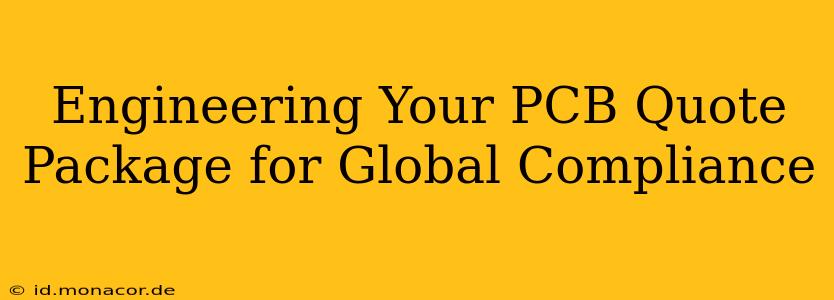Designing and manufacturing printed circuit boards (PCBs) involves navigating a complex web of global regulations and standards. A well-engineered PCB quote package isn't just about price; it's about ensuring your product meets all necessary compliance requirements, minimizing risks, and avoiding costly delays down the line. This comprehensive guide will walk you through the essential elements of a compliant PCB quote package, empowering you to make informed decisions and collaborate effectively with your PCB manufacturer.
What are the Key Compliance Standards for PCBs?
Numerous international and regional standards govern PCB design and manufacturing. Understanding these is crucial for a compliant quote. Key standards include:
- RoHS (Restriction of Hazardous Substances): This directive restricts the use of certain hazardous materials in electrical and electronic equipment, including PCBs. This is arguably the most widely known and critical standard.
- REACH (Registration, Evaluation, Authorisation and Restriction of Chemicals): A broader EU regulation, REACH covers a wider range of chemicals than RoHS, demanding detailed registration and assessment processes. Understanding REACH is vital for compliance, especially for PCBs destined for the European market.
- WEEE (Waste Electrical and Electronic Equipment): This directive focuses on the proper recycling and disposal of electronic waste, impacting the design and material choices for PCBs to facilitate end-of-life recycling.
- UL (Underwriters Laboratories): UL certifications are widely recognized safety standards for various electronic components and products, including PCBs, especially in North America. UL compliance signifies the product meets rigorous safety requirements.
- IEC (International Electrotechnical Commission): The IEC develops international standards for various electrical and electronic technologies. Many PCB-related standards fall under IEC’s purview, often referenced in national standards worldwide.
- FCC (Federal Communications Commission): For products intended for the US market, FCC compliance is essential, particularly relating to electromagnetic interference (EMI) and radio frequency interference (RFI).
These are just some of the major standards. Specific requirements can vary depending on the product's intended application, target market, and regional regulations.
How to Include Compliance Information in Your PCB Quote Request?
A detailed and well-structured PCB quote request is paramount for achieving global compliance. Here's what to include:
- Target Market: Clearly specifying the countries or regions where the final product will be sold is fundamental. This allows the manufacturer to identify the applicable standards and regulations.
- Material Specifications: Detail the desired materials for the PCB, ensuring they comply with RoHS, REACH, and other relevant restrictions. Specify whether you require specific certifications or declarations of compliance for the materials used.
- Compliance Certifications: State which certifications are required (e.g., UL, CE, FCC). Knowing these upfront allows the manufacturer to factor in the necessary testing and documentation.
- Testing Requirements: Clearly define the testing protocols and standards that must be met. This might include EMI/RFI testing, environmental testing, or other specific requirements.
- Documentation: Specify the type of documentation needed, such as Declarations of Conformity (DoC), certificates of analysis for materials, and test reports.
What Documentation Should You Expect from Your PCB Manufacturer?
A reputable PCB manufacturer will provide comprehensive documentation to support compliance. This might include:
- Material Declaration of Compliance: This document confirms that the materials used in the PCB adhere to regulations like RoHS and REACH.
- Test Reports: These reports detail the results of various tests conducted to ensure the PCB meets the specified standards (e.g., UL, IEC, FCC).
- Declaration of Conformity (DoC): This legal document asserts that the PCB complies with all applicable regulations.
- Certificates of Analysis (CoA): These provide detailed information about the chemical composition of the materials used.
How Much Does Global Compliance Add to the Cost of a PCB?
The additional cost of global compliance varies based on several factors:
- Complexity of the design: More complex PCBs may require more extensive testing and documentation.
- Required certifications: The number and type of certifications needed impact the overall cost.
- Material choices: Using compliant materials can sometimes be more expensive than non-compliant alternatives.
What Happens if Your PCB Doesn't Meet Compliance Standards?
Failing to meet compliance standards can lead to significant consequences:
- Product recalls: Non-compliant products may be recalled, resulting in considerable financial losses.
- Legal penalties: Companies may face fines or other legal penalties for violating regulations.
- Market access restrictions: Non-compliant products may be barred from sale in certain markets.
- Reputational damage: Compliance failures can severely damage a company's reputation.
By meticulously engineering your PCB quote package with compliance in mind, you're not just getting a circuit board; you're safeguarding your product's success and protecting your business from potential liabilities. Remember, proactive planning and clear communication with your manufacturer are key to ensuring a smooth and compliant production process.

